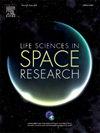Space radiation measured during first-ever commercial suborbital mission on Virgin Galactic SpaceShipTwo Unity on 29 June 2023
IF 2.8
3区 生物学
Q2 ASTRONOMY & ASTROPHYSICS
引用次数: 0
Abstract
The paper presents the variations of space radiation (primary and secondary galactic cosmic rays (GCR) absorbed dose rate in silicon and flux) measured during the first-ever commercial suborbital flight of the Virgin Galactic (VG) SpaceShipTwo Unity on 29 June 2023. A Portable Dosimeter-Spectrometer Liulin-CNR-VG is used. It is developed in the Space Research and Technology Institute, Bulgarian Academy of Sciences (SRTI-BAS) under a scientific contract with National Research Council of Italy (CNR), Italy. Liulin-CNR-VG size is 63х54 × 23 mm. Its weight is 0.092 kg. During the first part of the SpaceShipTwo flight, up to 14.4 km, the dose rate rises from 0.058 μGy h-1 up to 2.5 μGy h-1. Above the altitude of 30 km, the dose rate falls to 2.2 μGy h-1, while the dose to flux ratio increases to values about 1.0 nGy cm2 particle-1. The latter confirms the outcomes of previous balloon experiments, i.e. the change of the composition of the radiation field of the GCR and secondary radiation source from predominantly light particles as electrons, pions and muons towards heavier particles as protons and neutrons. On the descending part of the flight, one maximum in the flux and dose rate curves is obtained as Regener-Pfotzer maximum (R-PM). The flux calculated by the moving avervage is equal to 1.2 cm-2 s-1 and the dose rate is equal to 2.9 μGy h-1 at an altitude of 13 km. These values are well in line with those expected in conditions of relatively high solar activity, such as during the flight. The dose rates measured by Liulin-CNR-VG are in good agreement with other Liulin data, such as those recorded during balloon flights in 2005 and 2015 and civil aviation flights. The calculated total equivalent dose rate during the VG SpaceShipTwo flight is 7.46 μSv for 1.22 h. This reveals that there is a very small radiation risk for the pilots and astronauts flying at the VG SpaceShipTwo up to 85.1 1 km altitude.
2023年6月29日,维珍银河宇宙飞船二号Unity首次商业亚轨道任务期间测量的空间辐射。
本文介绍了2023年6月29日维珍银河(VG)宇宙飞船2号Unity首次商业亚轨道飞行期间测量的空间辐射(主要和次要星系宇宙射线(GCR)在硅中的吸收剂量率和通量)的变化。使用便携式剂量计-光谱仪Liulin-CNR-VG。它是在保加利亚科学院空间研究和技术研究所(SRTI-BAS)根据与意大利国家研究委员会(CNR)签订的科学合同开发的。柳林- cnr - vg尺寸为63х54 × 23 mm。它的重量是0.092公斤。在太空船2号飞行的第一部分,高达14.4公里,剂量率从0.058 μGy h-1上升到2.5 μGy h-1。在海拔30 km以上,剂量率降至2.2 μGy h-1,而剂量通量比上升至约1.0 nGy cm2粒子-1。后者证实了先前气球实验的结果,即GCR的辐射场组成和二次辐射源的变化,从主要的轻粒子(如电子、介子和μ子)向较重的粒子(如质子和中子)转变。在飞行下降段,在通量和剂量率曲线中得到一个最大值,称为再生-普氏最大值(R-PM)。在海拔13 km处,移动平均计算的通量为1.2 cm-2 s-1,剂量率为2.9 μGy h-1。这些数值与在太阳活动相对较高的情况下(例如在飞行期间)的预期值完全一致。柳林- cnr - vg测量的剂量率与其他柳林数据(如2005年和2015年气球飞行和民航飞行期间记录的剂量率)吻合良好。计算出VG太空船2号飞行1.22 h的总等效剂量率为7.46 μSv,这表明在VG太空船2号飞行至85.1 km高度时,飞行员和宇航员的辐射风险很小。
本文章由计算机程序翻译,如有差异,请以英文原文为准。
求助全文
约1分钟内获得全文
求助全文
来源期刊

Life Sciences in Space Research
Agricultural and Biological Sciences-Agricultural and Biological Sciences (miscellaneous)
CiteScore
5.30
自引率
8.00%
发文量
69
期刊介绍:
Life Sciences in Space Research publishes high quality original research and review articles in areas previously covered by the Life Sciences section of COSPAR''s other society journal Advances in Space Research.
Life Sciences in Space Research features an editorial team of top scientists in the space radiation field and guarantees a fast turnaround time from submission to editorial decision.
 求助内容:
求助内容: 应助结果提醒方式:
应助结果提醒方式:


